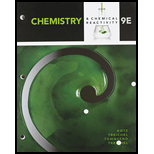
In the discussion on the composition of air, mention is made of the fact that water vapor may have a concentration as high as 40,000 ppm. Calculate the partial pressure exerted by water vapor at this concentration. Assume that this represents a situation with 100% humidity. What temperature would be needed to achieve this value? (See Appendix G.)
Interpretation:
The partial pressure exerted by water vapor at
Concept introduction:
Parts per million (ppm) concentrations: It is the ratio of the number of grams of solute for every one million grams of solution.
For gases, ppm refers to numbers of particles and hence to mole fraction. And the gas pressure exerted is directly proportional to the mole fraction.
Answer to Problem 1PS
The partial pressure exerted by water vapor at
Explanation of Solution
For gases, ppm refers to numbers of particles and hence to mole fraction. And the gas pressure exerted is directly proportional to the mole fraction.
The pressure exerted by water vapor at
This pressure partial pressure can be achieved if the temperature value reaches above
The partial pressure exerted by water vapor at
Want to see more full solutions like this?
Chapter 20 Solutions
Bundle: Chemistry & Chemical Reactivity, Loose-Leaf Version, 9th + OWLv2, 4 terms (24 Months) Printed Access Card
- Acetone peroxide, C9H18O6(s), is a powerful but highly unstable explosive that does not contain nitrogen. It can pass undetected through scanners designed to detect the presence of nitrogen in explosives like TNT (trinitrotoluene, C7H5N3O6), or ammonium nitrate. (a) Write a balanced equation for the combustion (burning in oxygen) of acetone peroxide producing steam and carbon dioxide. (b) What pressure is generated in a 2.00-L bottle when 5.00 g of acetone peroxide is ignited to 555C and burned in air? Assume 100% combustion.arrow_forwardA sample of a smoke stack emission was collected into a 1.25-L tank at 752 mm Hg and analyzed. The analysis showed 92% CO2, 3.6% NO, 1.2% SO2, and 4.1% H2O by mass. What is the partial pressure exerted by each gas?arrow_forwardApplication of gas laws to atmospheric sciencearrow_forward
- A gas-filled balloon having a volume of 3.80 L at 1.25 atm and 19°C is allowed to rise to the stratosphere (about 30 km above the surface of the Earth), where the temperature and pressure are −38°C and 8.20x 10−3 atm, respectively. Calculate the final volume of the balloon.arrow_forwardAtmospheric pressure decreases with increasing elevation. Explain why?arrow_forwardThe energy of the van der Waals bond, which is responsible for a number of the characteristics of water, is about 0.50 eV. (a) At what temperature would the average translational kinetic energy of water molecules be equal to this energy? (b) At that temperature, would water be liquid or gas? Under ordinary everyday conditions, do van der Waals forces play a role in the behavior of water?arrow_forward
- What are some of the efficient dry techniques to remove NOx and SO2 from polluted air at low temperatures (30-60 degree celsius)?arrow_forwardWhich statement is no of Brownian motion? It is independent of temperature. It is due to the random fluctuation of the energy content of the environment. It causes the random movement of pollen granules suspended in water. It is due to thermal noise.arrow_forwardSmall quantities of hydrogen gas can be prepared in the laboratory by the addition of aqueous hydrochloric acid to metallic zinc. Zn (s) + 2 HCl (aq) ZnCl2(aq) + H2(g) Typically, the hydrogen gas is bubbled through water for collection and becomes saturated with water vapor. Suppose 240.0 ml of hydrogen gas is collected at 30. ⁰C and has a total pressure reading of 1.032 atm by this process. a)What is the partial pressure of hydrogen gas in this sample? (The vapor pressure of water at this temperature equals to 0.042atm) b)Calculate how many moles of Hydrogen was produced? R= 0.08206 L.atm/mol.K c)How many grams of Znmust have reacted to produce this quantity of hydrogen gas? (Molar mass of Zn = 65.4 g/mol)arrow_forward
 Chemistry & Chemical ReactivityChemistryISBN:9781337399074Author:John C. Kotz, Paul M. Treichel, John Townsend, David TreichelPublisher:Cengage Learning
Chemistry & Chemical ReactivityChemistryISBN:9781337399074Author:John C. Kotz, Paul M. Treichel, John Townsend, David TreichelPublisher:Cengage Learning Chemistry & Chemical ReactivityChemistryISBN:9781133949640Author:John C. Kotz, Paul M. Treichel, John Townsend, David TreichelPublisher:Cengage Learning
Chemistry & Chemical ReactivityChemistryISBN:9781133949640Author:John C. Kotz, Paul M. Treichel, John Townsend, David TreichelPublisher:Cengage Learning Physical ChemistryChemistryISBN:9781133958437Author:Ball, David W. (david Warren), BAER, TomasPublisher:Wadsworth Cengage Learning,
Physical ChemistryChemistryISBN:9781133958437Author:Ball, David W. (david Warren), BAER, TomasPublisher:Wadsworth Cengage Learning, Chemistry: Principles and ReactionsChemistryISBN:9781305079373Author:William L. Masterton, Cecile N. HurleyPublisher:Cengage Learning
Chemistry: Principles and ReactionsChemistryISBN:9781305079373Author:William L. Masterton, Cecile N. HurleyPublisher:Cengage Learning Chemistry: The Molecular ScienceChemistryISBN:9781285199047Author:John W. Moore, Conrad L. StanitskiPublisher:Cengage Learning
Chemistry: The Molecular ScienceChemistryISBN:9781285199047Author:John W. Moore, Conrad L. StanitskiPublisher:Cengage Learning General, Organic, and Biological ChemistryChemistryISBN:9781285853918Author:H. Stephen StokerPublisher:Cengage Learning
General, Organic, and Biological ChemistryChemistryISBN:9781285853918Author:H. Stephen StokerPublisher:Cengage Learning





